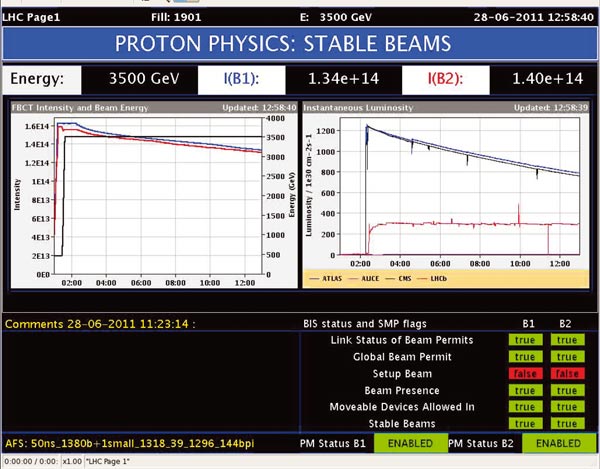
In June the LHC made good the promise of delivering an integrated luminosity of 1 fb–1 to the general-purpose detectors, ATLAS and CMS. This was the target for 2011 and it was achieved a little before the middle of the year. At the same time, making use of a technique known as “luminosity levelling”, the LHCb experiment had already recorded around 0.36 fb–1, well on the way to achieving its 1 fb–1 by the end of the year.
Reaching the luminosity milestone was the result of a programme of steady increments in the number of bunches of protons injected into the LHC, with 144 bunches added per beam per step. With each increment, the LHC provides three long “fills” of stable beams, before the next step. By the end of May, the number of bunches reached 1092 per beam, providing a peak luminosity of 1.25 × 1033 cm–2s–1 and a total energy per beam of some 70 MJ. A few long-lived fills soon yielded more than 40 pb–1 at a time for the general-purpose detectors, nearly as much as the LHC delivered in all of 2010, so allowing the 2011 milestone to be reached by 17 June.
The step to 1236 bunches per beam followed on 24 June, with the successful increment only four days later to 1380 bunches per beam – the maximum for the current bunch spacing of 50 ns. Running during these last few days of June included one epic fill that was 19 hours long and delivered an integrated luminosity of 60 pb–1.
At the same time, the technique of luminosity levelling has been employed to deliver a peak luminosity to the LHCb experiment of about 3 × 1032 cm–2s–1. If the beams were allowed to collide head-on in the LHCb detector, this figure would be exceeded, so the beams are initially separated by about 15 μm in the vertical plane. Then, as the beam intensity decays during a fill, this separation is gently reduced to keep the luminosity constant at the acceptable maximum. The LHCb experiment has more specialized physics goals than ATLAS and CMS, and was designed to run at lower luminosity and low multiplicity, processing just one proton–proton interaction per bunch crossing. The decision to increase the bunch intensity in the LHC before increasing the number of bunches, as well as the excellent performance of the detectors, has inspired the collaboration to run with as many as six interactions per crossing. The successful implementation of luminosity levelling means that the physics output of LHCb can be maximized while staying within the limits of peak luminosity that the detector can handle.

As the total beam intensity of the LHC has been pushed up, the operators have encountered various problems, such as the “unidentified falling objects” (UFOs). These are thought to be dust particles falling through the beam, causing localized beam loss. The losses can push nearby beam-loss monitors over the threshold to dump the beam. This is more of an annoyance than a danger for the LHC, but it does reduce the operational efficiency.
A period of machine development began on 29 June, in which the operators made several investigations for further improvements in the LHC’s performance, including the next steps towards higher beam intensities. One test involved the successful injection of trains of 24 bunches with 25 ns spacing, with up to 216 bunches injected. In other tests, bunches at 50 ns spacing were filled to twice the nominal intensity, with individual bunches at 2.7 × 1011 protons per bunch, the highest intensity achieved. These studies thus offer different paths to higher luminosities in the LHC.
Meanwhile, with the bumper crop of data already in hand, the LHC experiments are now working hard to get results ready for the main summer physics conferences: the European Physical Society’s High Energy Physics conference, being held in Grenoble on 21–27 July, and the Lepton-Photon conference, this year hosted by the Tata Institute in Mumbai on 22–27 August.
• For regular updates on the LHC, see the CERN Bulletin: http://cdsweb.cern.ch/journal/CERNBulletin/.





